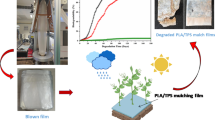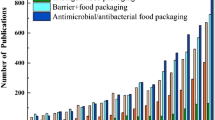Abstract
A study was undertaken to assess the effectiveness of plastic laminated collapsible tube as a packaging material for honey. Honey was packed in 100 ml capacity laminated tubes having a structure of linear low density polyethylene/aluminum foil/linear low density polyethylene and were exposed to 27 ± 2 °C and 65 ± 2% RH for a period of 12 months. The filled packages were withdrawn at regular intervals from the climatic chamber and product was analyzed in the laboratory. The physico-chemical parameters like moisture content, TSS, pH, etc., were found to be within the permissible limits. The moisture content ranged between 15.22 and 22.53% and TSS was 75.05 and 77.10°Bx. The pH (4.05–4.47) of honey remained unaffected during the entire period of storage and barrier properties of the laminated tubes showed synergistic interaction which inhibited the microbial growth. The honey samples showed overall higher sensory score and no changes in the packaging material in terms of softening, cracking, bulging or delamination were observed. So, it could be concluded that the barrier properties of the plastic laminated collapsible tube can maintain the keeping quality of honey for 370 days at normal storage conditions.






Similar content being viewed by others
References
Adriane AM, Ligia BA, María TS, Ana PM (2017) Composition and properties of Apis mellifera honey: a review. J Apic Res 57(1):5–37
Al-Habsi N, Niranjan K (2012) Effect of high hydrostatic pressure on antimicrobial activity and quality of Manuka honey. Food Chem 135:1448–1454
Alvarez-Suarez J, Tulipani Romandini S, Bertoli E, Battino M (2010) Contribution of honey in nutrition and human health: a review. Mediterr J NutrMetab 3:15–23
Amril A, Ladjama A (2013) Physicochemical characterization of some multifloral honeys from honeybees Apis mellifera collected in the Algerian northeast. Afr J Food Sci 7(7):168–173
Anand S, Mane D (2014) Collapsible tube for pharmaceutical use. Int J Pharm Chem Sci 3(2):391–398
Anjos O, Campos MG, Ruiz PC, Antunes P (2015) Application of FTIR-ATR spectroscopy to the quantification of sugar in honey. Food Chem 169:218–223
Bandeira AMP, Vasconcelos AA, Taube PS, Reis J, Filho B, Dias AL, Sousa Júnior JJV, Boger AE, Escher SKS (2018) Antimicrobial activity of honey produced in the West of the state of Pará. Brazil Acad J Microbiol Res 5(3):1–7
Bogdanov S (2011) Physical properties. In: S Bogdanov (ed.) The honey book, pp 19–27. http://www.bee-hexagon.net/honey/
Durrani A, Srivastava P, Verma S (2011) Development and quality evaluation of honey based carrot candy. J Food Sci Technol 48(4):502–505
El Sohaimy SA, Masry SHD, Shehata MG (2015) Physicochemical characteristics of honey from different origins. Ann Agric Sci 60(2):279–287
Eleazu CO, Iroaganachi M, Okoronkwo J (2013) Determination of the physico-chemical composition, microbial quality and free radical scavenging activities of some commercially sold honey samples in Aba, Nigeria: the effect of varying colours. J Nutr Food Sci 3(2):189
Elliott D (2010) Markets: toothpaste seeks fresh ideas [Digital Edition] packaging news magazine. http://www.packagingnews.co.uk/news/marketstoothpaste-seeks-fresh-ideas-05-05-2010
Escuredo O, Seijo M, Fernandez-Gonzalez M (2011) Descriptive analysis of rubus honey from the north-west of Spain. Int J Food Sci Technol 46:2329–2336
Ezeama CF (2007) Food microbiology, fundamental and applications. Natural Prints Limited, Lagos
Food Safety and Standards (2018) Food Products Standards and Food Additives Regulations, Food Safety and Standards Authority of India (FSSAI), New Delhi.
FSSAI Manual (2015) Manual for analysis of beverages (coffee, tea, cocoa, chicory), sugar and sugar products and confectionery products. Food Safety and Standards Authority of India, Lab Manual 4, pp 29–31
Gheldof N, Wang XH, Engeseth NJ (2002) Identification and quantification of antioxidant components of honeys from various floral sources. J Agric Food Chem 50(21):5870–5877
Hermanns R, Mateescu C, Thrasyvoulou A, Tananaki C, Wagener F, Cremers N (2019) Defining the standards for medical grade honey. J Apic Res 1–11.
International Honey Commission (2002) Harmonised Methods of the International Honey Commission. IHC, FAN, Liebefeld, CH-3003
IS 5402 (2012) Indian standard. Microbiology of food and animal feeding stuffs—horizontal method for the enumeration of microorganisms—colony count technique at 30 °C (second revision). Bureau of Indian Standards, pp 1–9
IS 5403 (1999) Indian standard. Method for yeast and mould count of foodstuffs and animal feeds (first revision). Bureau of Indian Standards, pp 1–3
Lawless HT, Heymann H (1998) Sensory evaluation of food, principles and practices. Aspen Publishers, Gaitherburg, p 827
Linkon R, Prodhan UK, Hakim MdA, Alim MdA (2015) Study on the physicochemical and antioxidant properties of Nigella honey. Int J Nutr Food Sci 4(2):137–140
Maria JS, Marcia RFG, Paulo HM, Rejane SP, Erica GL, Fernando AA (2017) Techniques for the evaluation of microbiological quality in honey, honey analysis. Vagner de Alencar Arnaut de Toledo, IntechOpen
Meo SA, Al-Asiri SA, Mahesar AL, Ansari MJ (2017) Role of honey in modern medicine. Saudi J Biol Sci 24:975–978
Monggudal MB, Radzi MNFM, Ismail MM, Ismail WIW (2018) Effect of six month storage on physicochemical analysis and antioxidant activity of several types of honey. IOP ConfSer Mater SciEng 440:012047. https://doi.org/10.1088/1757-899X/440/1/012047
Olaitan PB, Olufemi E, Adeleke IOO (2007) Honey: a reservoir for microorganisms and an inhibitory agent for microbes. Afr Health Sci 7(3):159–165
Prica N, Milica ŽB, Sandra J, Željko M, Brankica K, Jelena B, Sara S (2014) Moisture and acidity as indicators of the quality of honey originating from Vojvodina region. Arhiv Veterinarske Med 7(2):99–109
Ranganna S (2007) Handbook of analysis and quality control for fruit and vegetable products, 2nd edn. Tata McGraw Hill, New Delhi, p 1112
Rao PV, Krishnan KT, Salleh N, Gan SH (2016) Biological and therapeutic effects of honey produced by honey bees and stingless bees: a comparative review. Rev Bras Farmacogn 26:657–664. https://doi.org/10.1016/j.bjp.2016.01.012
Samarghandian S, Farkhondeh T, Samini F (2017) Honey and health: a review of recent clinical research. Pharmacogn Res 9(2):121–127
Slater S, Crichton T, Oakdene H (2011) Project report: recycling of laminated packaging. http://www.wrap.org.uk/sites/files/wrap/Recycling%20of%20laminated%20packaging.pdf
Vanhanen L, Emmertz A, Savage G (2011) Mineral analysis of mono-floral New Zealand honey. Food Chem 128:236–240
Zhou X, Taylor MP, Salouros H, Prasad S (2018) Authenticity and geographic origin of global honeys determined using carbon isotope ratios and trace elements. Nat Sci Rep 8(14639):1–11
Acknowledgement
The authors acknowledge the West Bengal Khadi and Village Industries Board for the financial assistance.
Author information
Authors and Affiliations
Corresponding author
Additional information
Publisher's Note
Springer Nature remains neutral with regard to jurisdictional claims in published maps and institutional affiliations.
Rights and permissions
About this article
Cite this article
Bhattacharjee, D., Patriwar, P., Ravandale, V. et al. Effect of Lamitubes Packaging on the Shelf Life of Honey. J Package Technol Res 5, 23–28 (2021). https://doi.org/10.1007/s41783-020-00105-w
Received:
Accepted:
Published:
Issue Date:
DOI: https://doi.org/10.1007/s41783-020-00105-w




